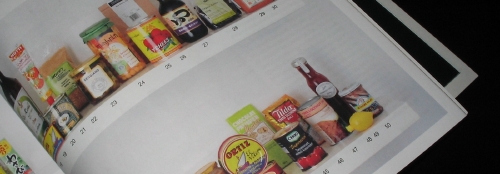Speaking of imaginary worlds created by cliques…

Close one eye, and you lose your depth perception, the ability to see behind things. So it is with Monocle, the Tyler Brulé pseudo-vanity project that I continue to buy in spite of itself and myself. Take the carefully arranged global pantry in ‘Shelf Life’:
While we spend a great deal of time sniffing and squeezing the fresh produce at Portobello Road market, we also spend a great deal of money on pantry staples at Globus in Zurich.
Do you bollocks.
Perhaps Tyler Brulé really does nip to Zurich for a half-kilo of coffee beans; if so, it says far more about his airmiles account than his nose for coffee. No matter what, it sums up the particular strain of globollocks in Monocle that both entices and infuriates, like a coke-fiend friend.
(You know that kind of person, the one with the fabulous lifestyle that’s always a nudge or a breath away from spinning out of control, but for the moment, bathes you with centripetal adrenaline.)
Monocle‘s world exists nowhere outside its pages. You don’t have to be a long-emergencist to appreciate that this is a moment of supreme cultural privilege, where the homesick expat can enjoy Jammie Dodgers and Test Match Special wherever there’s power, an array of local and foreign goods, and high-speed travel across continents, But it’s fundamentally unsustainable, and perhaps the sick thrill of the magazine is to tempt you otherwise.
The defining tension of Monocle lies between the extremes of macro and micro, its global depth-flattening eye privileging both the local and the localised. We’ve seen it before in Wallpaper* — the cult of Apoteket, for instance — but that was a design magazine, with certain liberties to play jet-speed magpie. This is something else: the subject of design is an entire fictive world, waiting to be branded and sold, with Brulé as the consumerist’s high-rent Borges or Nabokov. It’s the in-flight rag of Air Zembla.
As I put it in comments to Tom’s insightful post on place-branding:
Monocle is all about assemblages, a global Shangri-La constructed with a platinum flyer card and a bottomless expense account. It’s not so much an invisible city as an invisible world, or at least an invisible model of living.
It’s a journal of decadence, Gibbon’s late-Roman-Empire decadence. Not decadence of acquisition, the realm of the biz-class in-flight mag, but decadence of thought, decadence of vision, decadence of aspiration.
The world’s great bits of making are spezzati; you’ll find them gathered on a shelf only in a world of its own making.